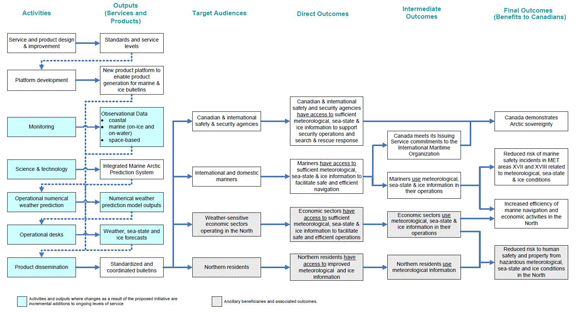Evaluation of Canada’s meteorological warning services for Arctic Ocean: chapter 9
Annex 1 Program Logic Model
View text version
Annex 1 shows the program logic model, which presents a graphical depiction of how the activities and outputs of Environment Canada’s meteorological services relate to direct, intermediate, and final outcomes of this sub-activity. Program activities lead to outputs which in turn lead to direct outcomes, then to immediate outcomes, and eventually to final outcomes.
Expected Program Activities:
- Service and product design and improvement
- Platform development
- Monitoring
- Science and technology
- Operational numerical weather prediction
- Operational desks
- Product dissemination
Expected Program Outputs (products and services):
- Standards and service levels
- New product platform to enable product generation for marine and ice bulletins
- Observational Data:
- Coastal
- Marine (on-ice and on-water)
- Space-based
- Integrated Marine Arctic Prediction System
- Numerical weather prediction model outputs
- Weather, sea-state and ice forecasts
- Standardized and coordinated bulletins
Targeted Audiences:
- Canadian and international safety and security agencies
- International and domestic mariners
- Weather-sensitive economic sectors operating in the North
- Northern residents
Expected Direct Outcomes:
- Canadians and international safety and security agencies have access to sufficient meteorological, sea-state and ice information to support security operations and search and rescue response
- Mariners have access to sufficient meteorological, sea-state and ice information to facilitate safe and efficient navigation
- Economic sectors have access to sufficient meteorological, sea-state and ice information to facilitate safe and efficient operations
- Northern residents have access to improved meteorological and ice information
Expected Intermediate Outcomes:
- Canada meets its Issuing Services commitments to the International Maritime Organization
- Mariners use meteorological, sea-state and ice information in their operations
- Economic sectors use meteorological, sea-state and ice information in their operations
- Northern residents use meteorological information
Expected Final Outcomes (Benefits to Canadians):
- Canada demonstrates Arctic sovereignty
- Reduced risk of marine safety incidents in MET areas XVII and XVIII related to meteorological, sea-state and ice conditions
- Increased efficiency of marine navigation and economic activities in the North
- Reduced risk to human safety and property from hazardous meteorological, sea-state and ice conditions in the North
